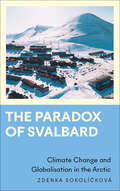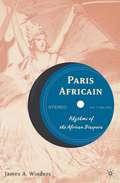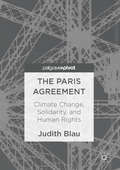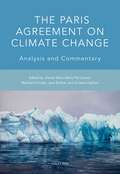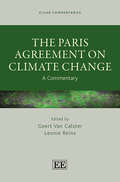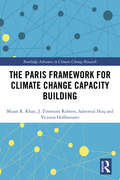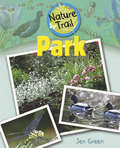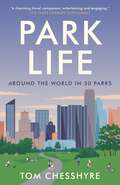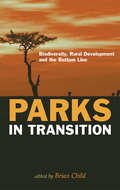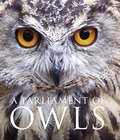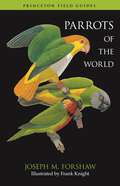- Table View
- List View
Paradise Found: Nature in America at the Time of Discovery
by Steve NichollsThe first Europeans to set foot on North America stood in awe of the natural abundance before them. The skies were filled with birds, seas and rivers teemed with fish, and the forests and grasslands were a hunter’s dream, with populations of game too abundant and diverse to even fathom. It’s no wonder these first settlers thought they had discovered a paradise of sorts. Fortunately for us, they left a legacy of copious records documenting what they saw, and these observations make it possible to craft a far more detailed evocation of North America before its settlement than any other place on the planet. Here Steve Nicholls brings this spectacular environment back to vivid life, demonstrating with both historical narrative and scientific inquiry just what an amazing place North America was and how it looked when the explorers first found it. The story of the continent’s colonization forms a backdrop to its natural history, which Nicholls explores in chapters on the North Atlantic, the East Coast, the Subtropical Caribbean, the West Coast, Baja California, and the Great Plains. Seamlessly blending firsthand accounts from centuries past with the findings of scientists today, Nicholls also introduces us to a myriad cast of characters who have chronicled the changing landscape, from pre–Revolutionary era settlers to researchers whom he has met in the field. A director and writer of Emmy Award–winning wildlife documentaries for the Smithsonian Channel, Animal Planet, National Geographic, and PBS, Nicholls deploys a cinematic flair for capturing nature at its most mesmerizing throughout. But Paradise Found is much more than a celebration of what once was: it is also a reminder of how much we have lost along the way and an urgent call to action so future generations are more responsible stewards of the world around them. The result is popular science of the highest order: a book as remarkable as the landscape it recreates and as inspired as the men and women who discovered it.
The Paradise Notebooks: 90 Miles across the Sierra Nevada
by Richard J. Nevle Steven NightingaleIn The Paradise Notebooks, Richard J. Nevle and Steven Nightingale take us across the spectacular Sierra Nevada mountain range on a journey illuminated by incandescent poetry and fascinating fact.Over the course of twenty-one pairs of short essays, Nevle and Nightingale contemplate the natural phenomena found in the Sierra Nevada. From granite to aspen, to fire, to a rare, endemic species of butterfly, these essay pairs explore the natural history and mystical wonder of each element with a balanced and captivating touch. As they weave in vignettes from their ninety-mile backpacking trip across the range, Nevle and Nightingale powerfully reconceive the Sierra Nevada as both earthly matter and transcendental offering, letting us into a reality in which nature holds just as much spiritual importance as it does physical.In a time of rapid environmental degradation, The Paradise Notebooks offers a way forward—a whole-minded, learned, loving attention to place that rekindles our joyful relationship with the living world.
Paradise Regained: The Regreening of Earth
by Greg Matloff C Bangs Les JohnsonWhat was our planet like before the advent of our modern civilization? What effects has our civilization had on the planet and its ecological systems? Paradise Regained discusses these questions and then creates a scenario for the re-greening of Earth. The authors introduce new and innovative ideas on how humankind might use the resources of the solar system for terrestrial benefit. Earth would then become a place for a technologically advanced human civilization to live in synchronization, if not in harmony, with the environment which gave us birth. Since the formation of our solar system, the resources and ecological state of Earth have undergone many changes. The environmental challenges facing humanity today, as the authors posit them, will not be resolved simply by conservation and Earth-based alternative technologies. Paradise Regained considers the environmental dilemma and highlights the risk of humankind's future extinction from environmental degradation. Human population growth, climate change, and the strained sustainability of the few remaining habitats for wild life are all discussed. The authors, however, are not discouraged and offer a potential solution through the development of space. Not only will extraterrestrial resources help avert environmental disaster, but will also provide the basis for continued technological and societal progress. The resources of the solar system will help meet our projected industrial needs and feed our industry once terrestrial sources are depleted. Space-based power generation systems will work synergistically with Earth-based conservation. Paradise Regained concludes with the discussion on how closed ecological systems in space will help us to build a prosperous and sustainable future for all humanity.
The Paradox of Svalbard: Climate Change and Globalisation in the Arctic (Anthropology, Culture and Society)
by Zdenka Sokolíčková‘Engaging, rich and nuanced, this book exposes the deep dilemmas facing this Arctic archipelago. A must for anyone with an interest in the challenges of a melting world. Ethnography at its best’ Marianne E. Lien, Professor, University of Oslo‘Rich and deeply textured ... Zdenka Sokolíčková demonstrates how the logic of extraction intersects awkwardly with community, environment, geopolitics and sustainability’ Klaus Dodds, Professor, Royal Holloway University of London‘Lucidly captures the dilemmas of maintaining community in the world’s northernmost settlement, where climate change is particularly evident. Highly recommended!’ Cecilie Vindal Ødegaard, Professor, University of BergenLongyearbyen in the Arctic is the world’s northernmost settlement. Here, climate change is happening fast. It is clearly sensed by the locals; with higher temperatures, more rain and permafrost thaw. At the same time, the town is shifting from state-controlled coal production to tourism, research and development. It is rapidly globalising, with numerous languages spoken, and with cruise ships sounding their horns in the harbour while planes land and take off.A small town of 2,400 inhabitants on the Norwegian archipelago of Svalbard, Longyearbyen provides a unique view into the unmistakable relationship between global capitalism and climate change. The Paradox of Svalbard looks at local and global trends to access a deep understanding of the effects of tourism, immigration and labour on the trajectory of the climate crisis, and what can be done to reverse it.Zdenka Sokolíčková is a researcher at the University of Hradec Králové, Czechia, and the University of Groningen in the Netherlands. Her research in Longyearbyen was hosted by the Department of Social Anthropology at the University of Oslo, Norway.
The Paradoxes of Aid Work: Passionate Professionals (Routledge Humanitarian Studies)
by Silke RothThis book explores what attracts people to aidwork and to what extent the promises of aidwork are fulfilled. 'Aidland' is a highly complex and heterogeneous context which includes many different occupations, forms of employment and organizations. Analysing the processes that lead to the involvement in development cooperation, emergency relief and human rights work and tracing the pathways into and through Aidland, the book addresses working and living conditions in Aidland, gender relations and inequality among aid personnel and what impact aidwork has on the life-courses of aidworkers. In order to capture the trajectories that lead to Aidland a biographical perspective is employed which reveals that boundary crossing between development cooperation, emergency relief and human rights is not unusual and that considering these fields as separate spheres might overlook important connections. Rich reflexive data is used to theorize about the often contradictory experiences of people working in aid whose careers are shaped by geo-politics, changing priorities of donors and a changing composition of the aid sector. Exploring the life worlds of people working in aid, this book contributes to the emerging sociology and anthropology of aidwork and will be of interest to professionals and researchers in humanitarian and development studies, sociology, anthropology, political science and international relations, international social work and social psychology.
The Paradoxes of Aid Work: Passionate Professionals (Routledge Humanitarian Studies)
by Silke RothThis book explores what attracts people to aidwork and to what extent the promises of aidwork are fulfilled. 'Aidland' is a highly complex and heterogeneous context which includes many different occupations, forms of employment and organizations. Analysing the processes that lead to the involvement in development cooperation, emergency relief and human rights work and tracing the pathways into and through Aidland, the book addresses working and living conditions in Aidland, gender relations and inequality among aid personnel and what impact aidwork has on the life-courses of aidworkers. In order to capture the trajectories that lead to Aidland a biographical perspective is employed which reveals that boundary crossing between development cooperation, emergency relief and human rights is not unusual and that considering these fields as separate spheres might overlook important connections. Rich reflexive data is used to theorize about the often contradictory experiences of people working in aid whose careers are shaped by geo-politics, changing priorities of donors and a changing composition of the aid sector. Exploring the life worlds of people working in aid, this book contributes to the emerging sociology and anthropology of aidwork and will be of interest to professionals and researchers in humanitarian and development studies, sociology, anthropology, political science and international relations, international social work and social psychology.
Parameter Redundancy and Identifiability (Chapman & Hall/CRC Interdisciplinary Statistics)
by Diana ColeStatistical and mathematical models are defined by parameters that describe different characteristics of those models. Ideally it would be possible to find parameter estimates for every parameter in that model, but, in some cases, this is not possible. For example, two parameters that only ever appear in the model as a product could not be estimated individually; only the product can be estimated. Such a model is said to be parameter redundant, or the parameters are described as non-identifiable. This book explains why parameter redundancy and non-identifiability is a problem and the different methods that can be used for detection, including in a Bayesian context. Key features of this book: Detailed discussion of the problems caused by parameter redundancy and non-identifiability Explanation of the different general methods for detecting parameter redundancy and non-identifiability, including symbolic algebra and numerical methods Chapter on Bayesian identifiability Throughout illustrative examples are used to clearly demonstrate each problem and method. Maple and R code are available for these examples More in-depth focus on the areas of discrete and continuous state-space models and ecological statistics, including methods that have been specifically developed for each of these areas This book is designed to make parameter redundancy and non-identifiability accessible and understandable to a wide audience from masters and PhD students to researchers, from mathematicians and statisticians to practitioners using mathematical or statistical models.
Parameter Redundancy and Identifiability (Chapman & Hall/CRC Interdisciplinary Statistics)
by Diana ColeStatistical and mathematical models are defined by parameters that describe different characteristics of those models. Ideally it would be possible to find parameter estimates for every parameter in that model, but, in some cases, this is not possible. For example, two parameters that only ever appear in the model as a product could not be estimated individually; only the product can be estimated. Such a model is said to be parameter redundant, or the parameters are described as non-identifiable. This book explains why parameter redundancy and non-identifiability is a problem and the different methods that can be used for detection, including in a Bayesian context. Key features of this book: Detailed discussion of the problems caused by parameter redundancy and non-identifiability Explanation of the different general methods for detecting parameter redundancy and non-identifiability, including symbolic algebra and numerical methods Chapter on Bayesian identifiability Throughout illustrative examples are used to clearly demonstrate each problem and method. Maple and R code are available for these examples More in-depth focus on the areas of discrete and continuous state-space models and ecological statistics, including methods that have been specifically developed for each of these areas This book is designed to make parameter redundancy and non-identifiability accessible and understandable to a wide audience from masters and PhD students to researchers, from mathematicians and statisticians to practitioners using mathematical or statistical models.
Parasitic Plants in African Agriculture
by Professor Lytton John Musselman Dr Jonne RodenburgParasitic Plants in African Agriculture brings together for the first time in a single volume, the ecology, biology, damage, and control of all groups of African parasitic plants including both the relatively few parasites introduced to the continent as well as those native parasites that have spread from within Africa. The book covers the well-known witchweeds and broomrapes but also groups and species that have received less attention including mistletoes, dodders, rice vampire weed, and other species posing threats. The book distinguishes between stem and root parasitic weeds and between holoparasites and (facultative or obligate) hemiparasites. Based on their research and experience collectively spanning six decades, the authors provide an authoritative and state-of-the-art overview of the distribution, biology and impact of these highly specialized weeds and include recommendations for their management. Since parasitic plants in African agriculture primarily affect smallholder farmers, these weeds are explicitly discussed within a context of resource limitations and global changes. Readers are informed on all parasitic plant species relevant to African agriculture and the impact these plants have on crop production and livelihoods of smallholders in a changing world. Current and future management strategies are outlined in terms of their principles and effectiveness as well as their feasibility and affordability for farmers, all of which determine farmer adoption. The final chapter synthesises some of the relevant findings and statistics regarding parasitic weed distribution and their host crops and discusses implications in terms of future crop protection concerns in African agricultural systems. Key features: · Authoritative text based on extensive field and laboratory work. · First comprehensive state-of-the-art overview of parasitic plants and their management in Africa. · Highly illustrated with photos, graphs and species distribution maps. · Reviews previous basic and applied work, with relevance to smallholder farming systems. This book will be a valuable reference for students, researchers, extension workers, development officers, national agriculture researchers, plant pathologists, food security specialists, weed scientists, agronomists and botanists.
Paris Africain: Rhythms of the African Diaspora
by J. WindersThe growth of African immigration to France at the end of the Twentieth Century wrought cultural change in this epicentre of the avant-garde in European art and music. James Winders presents the story of African immigrants to France as a unique chapter in the long history of the reception accorded expatriate artists in Paris.
The Paris Agreement: Climate Change, Solidarity, and Human Rights
by Judith BlauThis book discusses the immediate and severe threat posed by global climate change and the various obstacles that stand in the way of action. Judith Blau presents scientific evidence relevant to The Paris Agreement (COP-21): an international treaty that promises to strengthen the global response to climate change. As she reckons with the dangers of catastrophic planetary heating, Blau discusses the clash between the deeply ingrained American tradition of individualism and the collective action and acknowledgement of intertwined fate needed to address climate change. She acknowledges that America’s capitalist bent stands in contrast to the idea of the “commons”—a concept that we need to embrace if climate change is to be mitigated. The volume also explains the foundations of international human rights standards as they relate to climate change. Drawing from guiding principles of human rights and equality, the book concludes hopefully—suggesting that the people of the world can meet the challenge posed by climate change by at once acknowledging shared humanity and celebrating difference.
The Paris Agreement: Climate Change, Solidarity, and Human Rights
by Judith BlauThis book discusses the immediate and severe threat posed by global climate change and the various obstacles that stand in the way of action. Judith Blau presents scientific evidence relevant to The Paris Agreement (COP-21): an international treaty that promises to strengthen the global response to climate change. As she reckons with the dangers of catastrophic planetary heating, Blau discusses the clash between the deeply ingrained American tradition of individualism and the collective action and acknowledgement of intertwined fate needed to address climate change. She acknowledges that America’s capitalist bent stands in contrast to the idea of the “commons”—a concept that we need to embrace if climate change is to be mitigated. The volume also explains the foundations of international human rights standards as they relate to climate change. Drawing from guiding principles of human rights and equality, the book concludes hopefully—suggesting that the people of the world can meet the challenge posed by climate change by at once acknowledging shared humanity and celebrating difference.
The Paris Agreement on Climate Change: Analysis and Commentary
by Daniel Klein, María Pía Carazo, Meinhard Doelle, Jane Bulmer, and Andrew HighamThe most important climate agreement in history, the Paris Agreement on Climate Change represents the commitment of the nations of the world to address and curb climate change. Signed in December 2015, it entered into force on 4th November 2016. Countries are moving into implementation, and efforts at all levels will be needed to fulfill its ambitious goals. The Paris Climate Agreement: Commentary and Analysis combines a comprehensive legal appraisal and critique of the new Agreement with a practical and structured commentary to and social drivers behind it, providing an overview of the pre-existing regime, and tracking the history of the negotiations. It examines the evolution of key concepts such as common but differentiated responsibilities, and analyses the legal form of the Agreement and the nature of its provisions. Part II comprises individual chapters on each Article of the Agreement, with detailed commentary of the provisions which highlights central aspects from the negotiating history and the legal nature of the obligations. It describes the institutional arrangements and considerations for national implementation, providing practical advice and prospects for future development. Part III reflects on the Paris Agreement as a whole: its strengths and weaknesses, its potential for further development, and its relationship with other areas of public international law and governance. The book is an invaluable resource for academics and practitioners, policy makers, and actors in the private sector and civil society, as they negotiate the implementation of the Agreement in domestic law and policy.
The Paris Agreement on Climate Change: A Commentary (Elgar Commentaries series)
Providing in-depth coverage of each article of the Paris Agreement, this Commentary offers a comprehensive, legal analysis of this most recent and important international instrument on climate change. This provision-by-provision textual analysis examines the commitments that parties to the Agreement have made to undertake ambitious efforts to combat climate change and adapt to its effects, whilst providing additional support to developing countries. Describing the history, implementation and operation of the Paris Agreement, this Commentary is indispensable for obtaining a deep and nuanced understanding of the way in which the global community seeks to intensify its efforts to address climate change. Written by internationally renowned contributors, it discusses recent examples of implementation of the Agreement and nationally determined contributions (NDCs). Clearly written and accessible, this Commentary will be a vital resource for policy makers and government officials involved in climate change across the globe, whilst also being valuable for practitioners, scholars and students of climate change law and policy.
The Paris Agreement on Climate Change: Analysis and Commentary
The most important climate agreement in history, the Paris Agreement on Climate Change represents the commitment of the nations of the world to address and curb climate change. Signed in December 2015, it entered into force on 4th November 2016. Countries are moving into implementation, and efforts at all levels will be needed to fulfill its ambitious goals. The Paris Climate Agreement: Commentary and Analysis combines a comprehensive legal appraisal and critique of the new Agreement with a practical and structured commentary to and social drivers behind it, providing an overview of the pre-existing regime, and tracking the history of the negotiations. It examines the evolution of key concepts such as common but differentiated responsibilities, and analyses the legal form of the Agreement and the nature of its provisions. Part II comprises individual chapters on each Article of the Agreement, with detailed commentary of the provisions which highlights central aspects from the negotiating history and the legal nature of the obligations. It describes the institutional arrangements and considerations for national implementation, providing practical advice and prospects for future development. Part III reflects on the Paris Agreement as a whole: its strengths and weaknesses, its potential for further development, and its relationship with other areas of public international law and governance. The book is an invaluable resource for academics and practitioners, policy makers, and actors in the private sector and civil society, as they negotiate the implementation of the Agreement in domestic law and policy.
Paris Climate Agreement: Beacon Of Hope (Springer Climate)
by Ross J. Salawitch Timothy P. Canty Austin P. Hope Walter R. Tribett Brian F. BennettThis book is open access under a CC BY 4.0 license.This volume presents an Empirical Model of Global Climate developed by the authors and uses that model to show that global warming will likely remain below 2ºC, relative to preindustrial, throughout this century provided: a) both the unconditional and conditional Paris INDC commitments are followed; b) the emission reductions needed to achieve the Paris INDCs are carried forward to 2060 and beyond.The first section of the book provides a short overview of Earth’s climate system, describing and contrasting climatic changes throughout the planet’s history and anthropogenic changes post-Industrial Revolution. The second section describes the climate model developed by the authors (Canty et al., Atmospheric Chemistry and Physics, 2013) and contrasts the model with climate models used in the Intergovernmental Panel on Climate Change (IPCC) 2013 Report. Chapter 3 examines both the unconditional (i.e., firm commitments) and conditional Paris INDCs (commitments contingent on financial flow and/or technology transfer) through the lens of their climate model and concludes that if all of the Paris INDCs are followed, then they are indeed a beacon of hope for Earth’s climate. The fourth part of the book offers a perspective of energy needs and subsequent emissions reductions required to meet the Paris temperature goals, illuminating challenges faced both in the developing world and the developed world.Throughout the book, easy-to-understand charts and graphics illustrate concepts. The scientific basis of Chapters 2 and 3 was first presented in a keynote session of the 96th Annual Meeting of the American Meteorological Society in January, 2016.
Paris Climate Agreement: Lessons Learned from the Compliance Mechanisms of the Kyoto and Montreal Protocols (The Anthropocene: Politik—Economics—Society—Science #11)
by Zerrin SavaşanThis book discusses options for an improved compliance system under the Paris Climate Agreement by addressing current weaknesses. The research is based on two cases, the Compliance Mechanisms of the Montreal and Kyoto Protocols and their outcomes in practice. This book analysed the different meanings of tthe compliance concept of Compliance Mechanisms (CMs) and Multilateral Environmental Agreements (MEAs) in chapter 3, on the theories and two basic explanatory models on compliance (chapter 4), on the development of CMs and the limitations of traditional means (chapter 5), and the questions on the CMs under the Kyoto and the Montreal Protocols (chapter 6). Based on its findings, options for an improved compliance system under the Paris Climate agreement are asked (chapter 7). This book • Offers a detailed understanding of compliance and existing compliance mechanisms (CMs),• elaborates the CMs' present features on the basis of its case studies,• includes the latest information on CMs and its case studies,• discusses options for an improved compliance system under the Paris Climate Agreement figuring out the current weaknesses
The Paris Framework for Climate Change Capacity Building (Routledge Advances in Climate Change Research)
by Mizan R Khan J. Timmons Roberts Saleemul Huq Victoria HoffmeisterThe Paris Framework for Climate Change Capacity Building pioneers a new era of climate change governance, performing the foundational job of clarifying what is meant by the often ad-hoc, one-off, uncoordinated, ineffective and unsustainable practices of the past decade described as 'capacity building' to address climate change. As an alternative, this book presents a framework on how to build effective and sustainable capacity systems to meaningfully tackle this long-term problem. Such a reframing of capacity building itself requires means of implementation. The authors combine their decades-long experiences in climate negotiations, developing climate solutions, climate activism and peer-reviewed research to chart a realistic roadmap for the implementation of this alternative framework for capacity building. As a result, this book convincingly makes the case that universities, as the highest and sustainable seats of learning and research in the developing countries, should be the central hub of capacity building there. This will be a valuable resource for students, researchers and policy-makers in the areas of climate change and environmental studies.
The Paris Framework for Climate Change Capacity Building (Routledge Advances in Climate Change Research)
by Mizan R Khan J. Timmons Roberts Saleemul Huq Victoria HoffmeisterThe Paris Framework for Climate Change Capacity Building pioneers a new era of climate change governance, performing the foundational job of clarifying what is meant by the often ad-hoc, one-off, uncoordinated, ineffective and unsustainable practices of the past decade described as 'capacity building' to address climate change. As an alternative, this book presents a framework on how to build effective and sustainable capacity systems to meaningfully tackle this long-term problem. Such a reframing of capacity building itself requires means of implementation. The authors combine their decades-long experiences in climate negotiations, developing climate solutions, climate activism and peer-reviewed research to chart a realistic roadmap for the implementation of this alternative framework for capacity building. As a result, this book convincingly makes the case that universities, as the highest and sustainable seats of learning and research in the developing countries, should be the central hub of capacity building there. This will be a valuable resource for students, researchers and policy-makers in the areas of climate change and environmental studies.
Park (Nature Trail #2)
by Jen GreenThis is a science series for children aged six to eight which will teach pupils about the habitats around them. It also covers plant life and animal life.
Park Life: Around the World in 50 Parks
by Tom ChesshyreIf the pandemic has taught us one thing, it's that people love parks Wherever we are in the world, urban parks are places where we can find calm amid the chaos. With fondness and humour, travel writer Tom Chesshyre recalls 50 of his favourite urban parks from across the world, in a love letter to the green escapes that bring us joy in our cities.
Parks in Transition: "Biodiversity, Rural Development and the Bottom Line"
by Brian ChildParks face intense pressure from both environmental and developmental perspectives to conserve biodiversity and provide economic opportunities for rural communities. These imperatives are often in conflict, while potential solutions may be subject to theoretical and practical disagreement and complicated by pressing economic, political and cultural considerations. Parks in Transition collects the work of the most distinguished scholars and practitioners in this field, drawing on insight from over 50 case studies and synthesizing them into lessons to guide park management in transitional economies where the challenges of poverty and governance can be severe. The central message of the book is that parks are common property regimes that are supposed to serve society. It analyses and sheds light on the crucial questions arising from this perspective. If parks are set aside to serve poor people, should conservation demands over-rule demands for jobs and economic growth? Or will deliberately using parks as bridgeheads for better land use and engines for rural development produce more and better conservation? The issue that arises at all levels is that of accountability, including the problematic linkages between park authorities and political systems, and the question of how to measure park performance. This book provides vital new insights for park management, regarding the relationship between conservation and commercialization, performance management, new systems of governance and management, and linkages between parks, landscape and the land-use economy.
Parks in Transition: "Biodiversity, Rural Development and the Bottom Line"
by Brian ChildParks face intense pressure from both environmental and developmental perspectives to conserve biodiversity and provide economic opportunities for rural communities. These imperatives are often in conflict, while potential solutions may be subject to theoretical and practical disagreement and complicated by pressing economic, political and cultural considerations. Parks in Transition collects the work of the most distinguished scholars and practitioners in this field, drawing on insight from over 50 case studies and synthesizing them into lessons to guide park management in transitional economies where the challenges of poverty and governance can be severe. The central message of the book is that parks are common property regimes that are supposed to serve society. It analyses and sheds light on the crucial questions arising from this perspective. If parks are set aside to serve poor people, should conservation demands over-rule demands for jobs and economic growth? Or will deliberately using parks as bridgeheads for better land use and engines for rural development produce more and better conservation? The issue that arises at all levels is that of accountability, including the problematic linkages between park authorities and political systems, and the question of how to measure park performance. This book provides vital new insights for park management, regarding the relationship between conservation and commercialization, performance management, new systems of governance and management, and linkages between parks, landscape and the land-use economy.
A Parliament of Owls
by Mike UnwinA unique collection of stunning photographs and detailed portraits of over fifty of the most striking owl species around the world. Recommended for viewing on a colour tablet.
Parrots of the World
by Joseph M. Forshaw Frank KnightFrom the macaws of South America to the cockatoos of Australia, parrots are among the most beautiful and exotic birds in the world--and also among the most endangered. This stunningly illustrated, easy-to-use field guide covers all 356 species and well-differentiated subspecies of parrots, and is the only guide organized by geographical distribution--Australasian, Afro-Asian, and neotropical. It features 146 superb color plates depicting every kind of parrot, as well as detailed, facing-page species accounts that describe key identification features, distribution, subspeciation, habitat, and status. Color distribution maps show ranges of all subspecies, and field identification is further aided by relevant upperside and underside flight images. This premier field guide also shows where to observe each species in the wild, helping make this the most comprehensive and user-friendly guide to the parrots of the world. The only parrot guide to focus on geographical distribution Covers all 356 species Features 146 color plates depicting all species and well-differentiated subspecies Provides detailed facing-page species accounts that describe key identification features, distribution, subspeciation, habitat, and status Includes color distribution maps Shows where to observe each species in the wild



